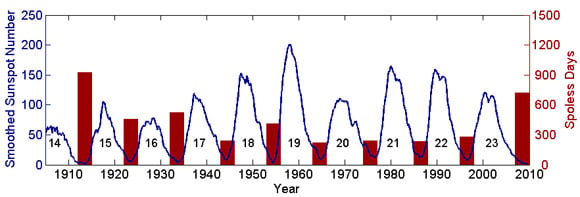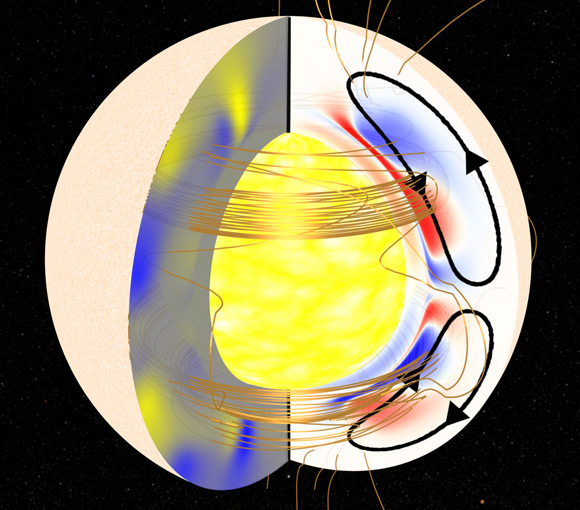Original URL: https://www.theregister.com/2011/03/03/sunspot_mystery/
Scientists crack spotless Sun mystery
Temperamental conveyor belt to blame for deep solar minimum
Posted in Science, 3rd March 2011 12:13 GMT
Scientists reckon they've cracked the mystery as to why during 2008-2009, the Sun was completely devoid of sunspots for almost two years.
This deepest solar minimum in a century, marking the end of sunspot cycle 23, saw the Sun's global magnetic field and solar wind weaken, allowing dangerous cosmic rays to sweep the inner solar system.

It also prompted a cooling and collapse of Earth's upper atmosphere in the absence of the UV ray heating normally provided by sunspot activity.
"Space junk stopped decaying as rapidly as usual and started accumulating in Earth orbit," NASA explains.
Just why the Sun went quiet for so long has until now had boffins scratching their heads, but a team led by Dibyendu Nandi of the Indian Institute of Science Education and Research in Kolkata says it has the answer.
Nandi declared: "Plasma currents deep inside the sun interfered with the formation of sunspots and prolonged solar minimum. Our conclusions are based on a new computer model of the sun's interior."

The crux of the matter is the behaviour of the "Great Conveyor Belt", represented in the above graphic as black arrowed loops.
NASA explains: "A vast system of plasma currents called ‘meridional flows’ (akin to ocean currents on Earth) travel along the sun's surface, plunge inward around the poles, and pop up again near the sun's equator. These looping currents play a key role in the 11-year solar cycle.
"When sunspots begin to decay, surface currents sweep up their magnetic remains and pull them down inside the star; 300,000 km below the surface, the sun’s magnetic dynamo amplifies the decaying magnetic fields. Re-animated sunspots become buoyant and bob up to the surface like a cork in water—voila! A new solar cycle is born."
Team member Andrés Muñoz-Jaramillo, of the Harvard-Smithsonian Center for Astrophysics, said: "According to our model, the trouble with sunspots actually began in back in the late 1990s during the upswing of Solar Cycle 23. At that time, the conveyor belt sped up."
The belt "rapidly dragged sunspot corpses down to sun's inner dynamo for amplification", but although this might suggest a boost in sunspot production, the remains "rode the belt through the amplification zone too hastily for full re-animation".
NASA continues: "Later, in the 2000s, according to the model, the Conveyor Belt slowed down again, allowing magnetic fields to spend more time in the amplification zone, but the damage was already done. New sunspots were in short supply. Adding insult to injury, the slow moving belt did little to assist re-animated sunspots on their journey back to the surface, delaying the onset of Solar Cycle 24."
The scientists, whose results are published in today's issue of Nature (subscription required), reckon helioseismology data from the Solar Dynamics Observatory (SDO) could in future be plugged into their model "to predict how future solar minima will unfold".
Lika Guhathakurta of NASA’s Heliophysics Division in Washington concluded that "finally, we may be cracking the mystery of the spotless sun."
NASA has more here. ®
Bootnote
Here's a nice vid from the SDO, captured last week:
NASA explains: "When a rather large M 3.6 class flare occurred near the edge of the Sun on Feb. 24, 2011, it blew out a gorgeous, waving mass of erupting plasma that swirled and twisted for 90 minutes. NASA’s Solar Dynamics Observatory captured the event in extreme ultraviolet light. Because SDO images are high definition, the team was able to zoom in on the flare and still see exquisite details. And using a cadence of a frame taken every 24 seconds, the sense of motion is, by all appearances, seamless."